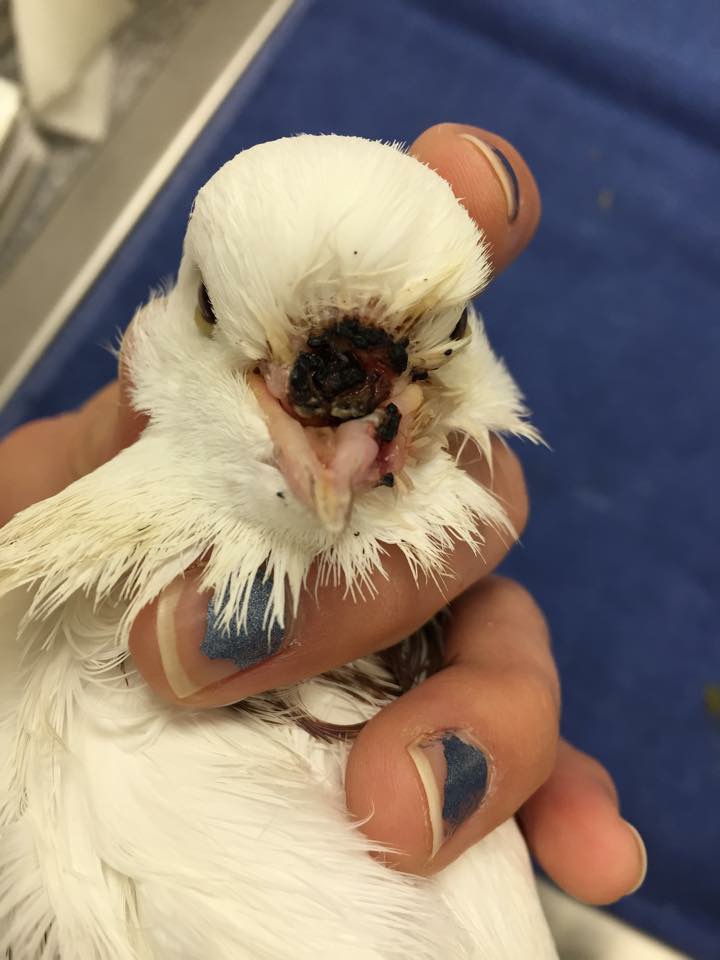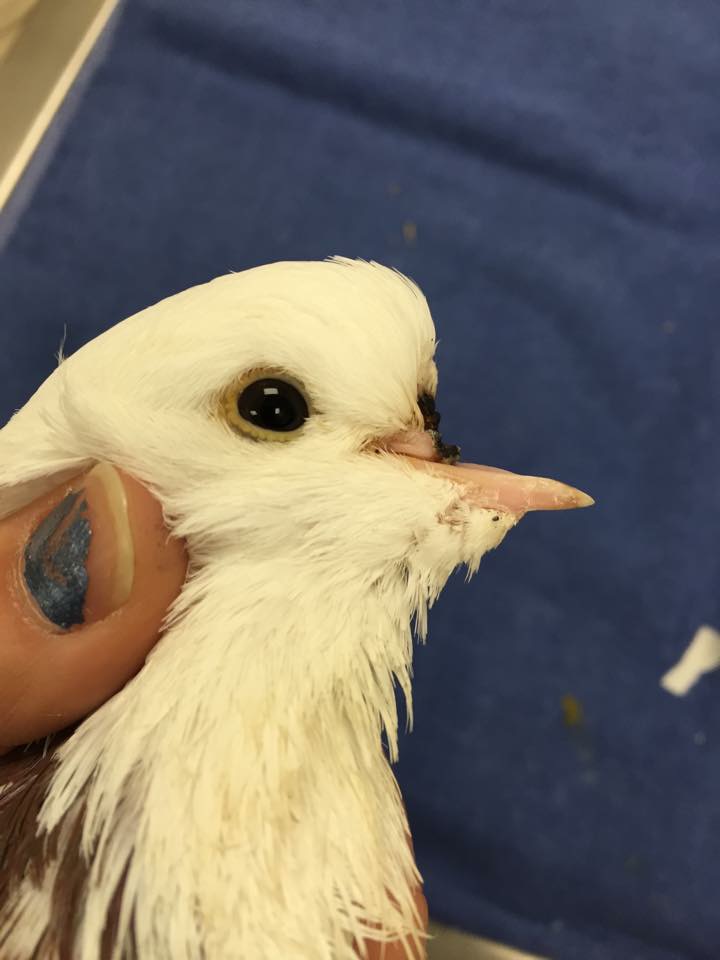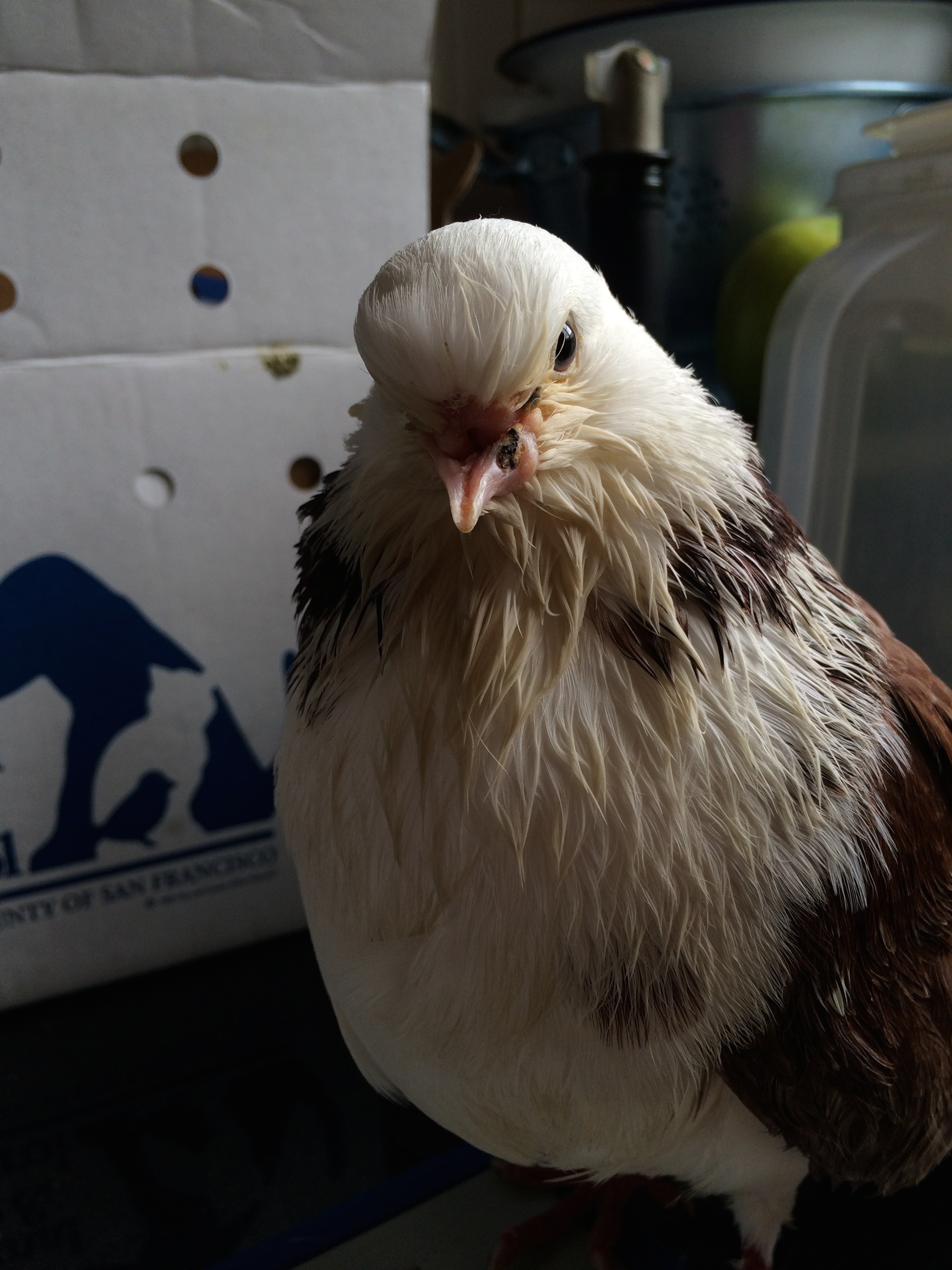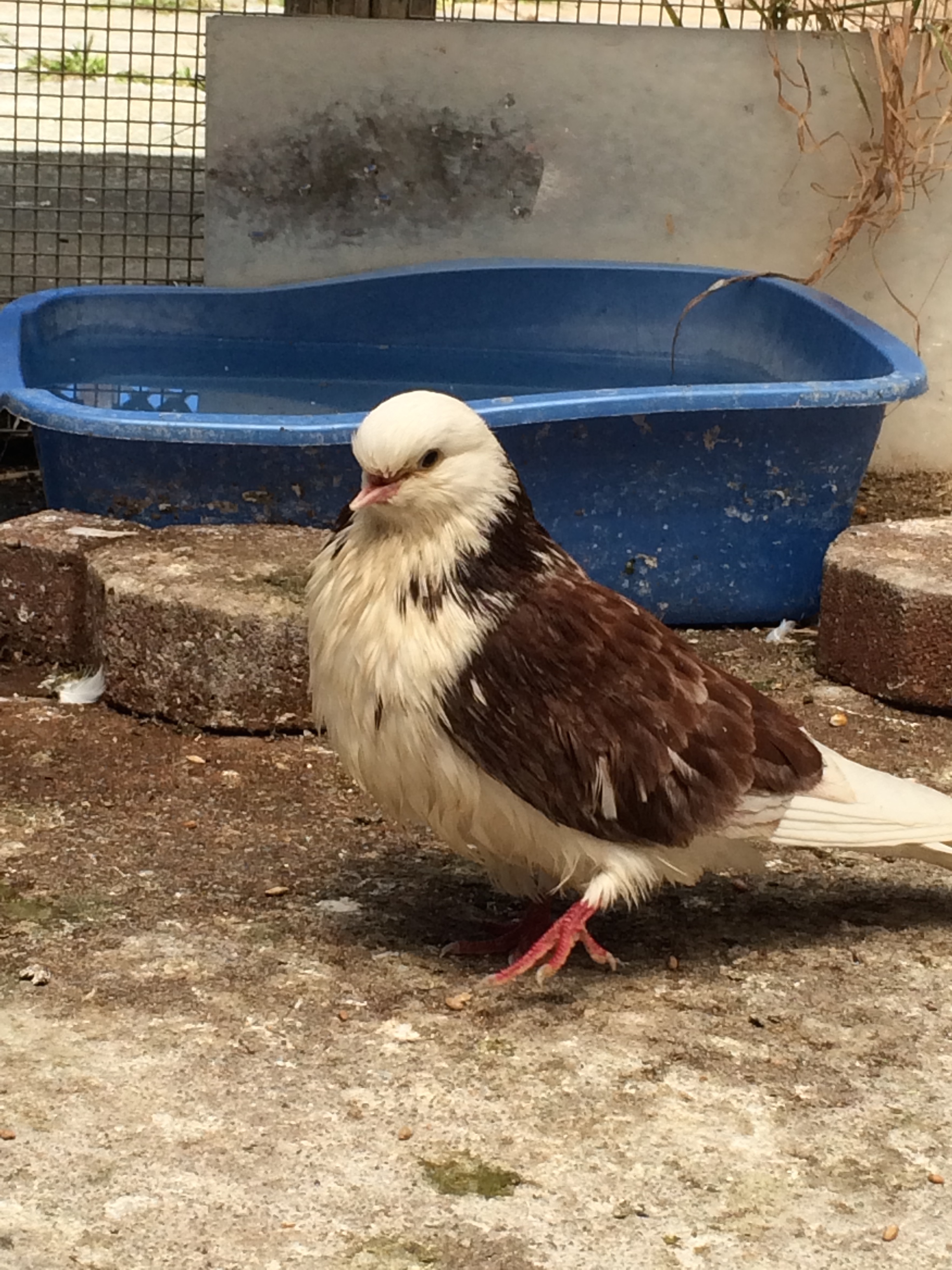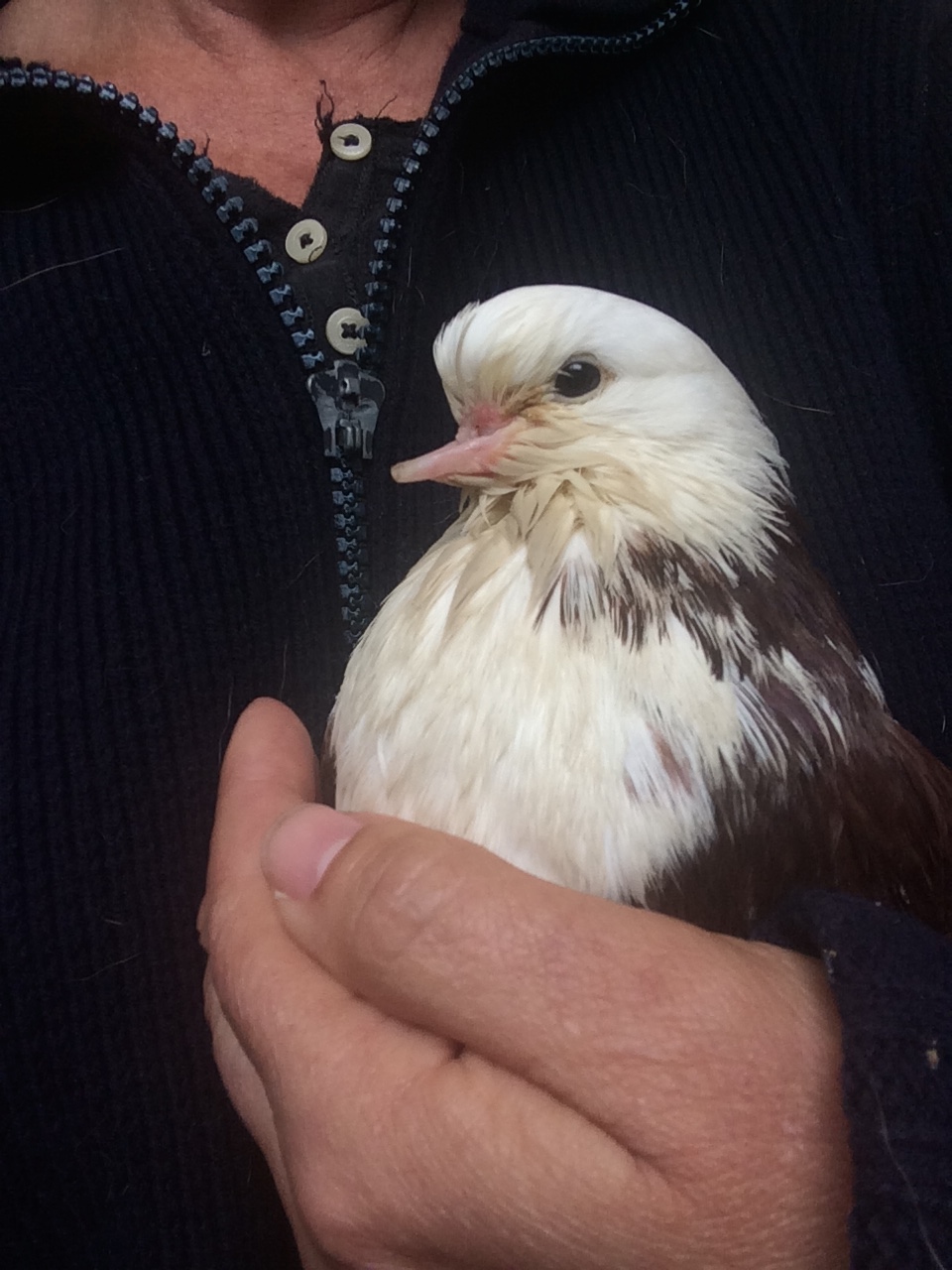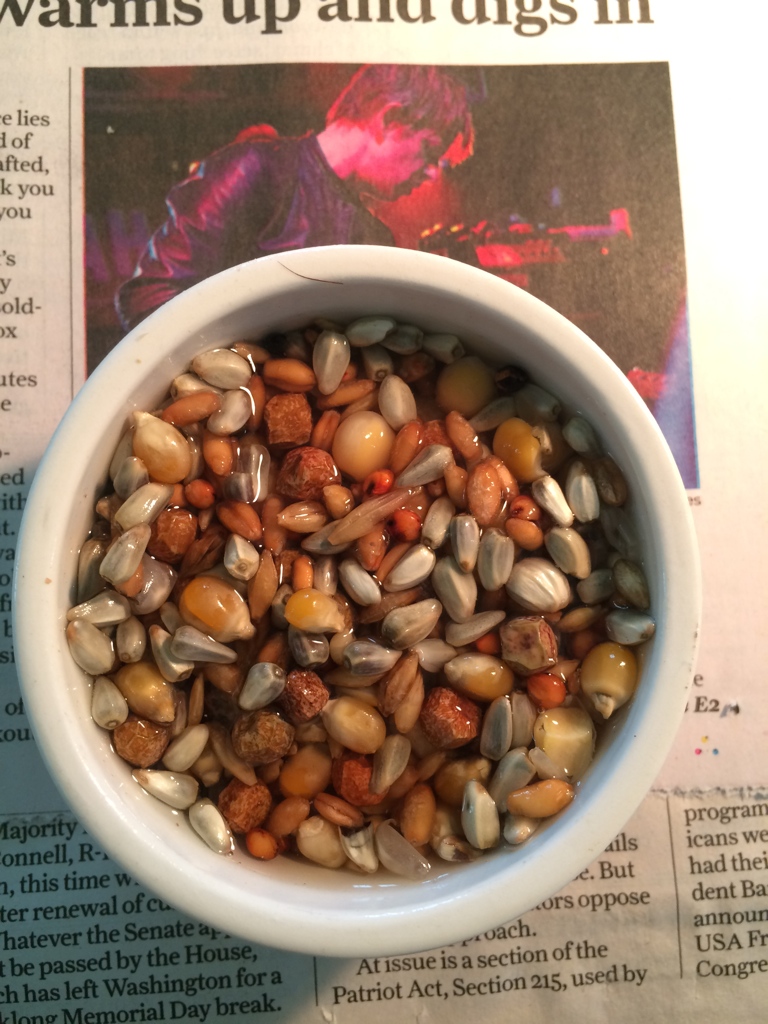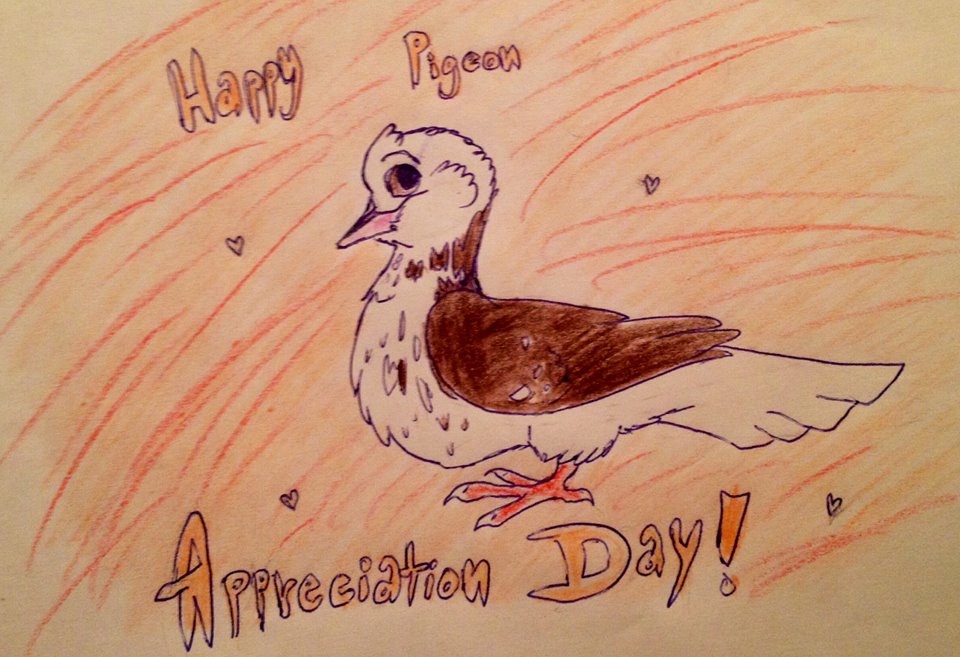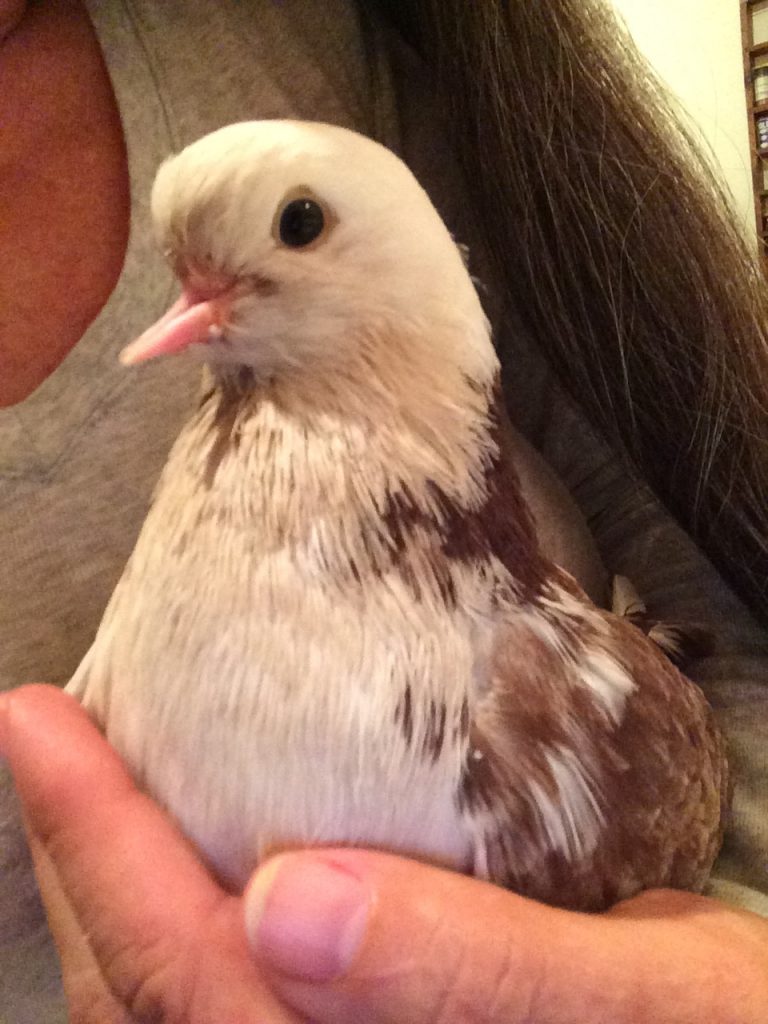On 4/1/15, a brown & white Persian High Flyer pigeon with a startling injury approached a kind person in Sacramento who took him to Wildlife Care Association (WCA). The bird’s upper beak was entirely gone, torn from his face. Brianna of WCA took care of his immediate needs with pain meds, antibiotics and supportive care and reached out to us, Palomacy Pigeon & Dove Adoptions, for his long term care. Brianna named him Fleetwood. We were able, with the help of a volunteer from Mickaboo (our big sister parrot rescue), to get Fleetwood transported to our avian vets at Medical Center for Birds.
Aside from the disabling wound (which included a punture into the lower mandible as well), Fleetwood was in surprisingly good condition. The wound was recent. His injury was such that his beak would never grow back and, because there was not even a stump left for attachment, he is considered a poor prospect for a prosthetic beak. Now he needed to heal and relearn how to feed himself with only half a beak.
Fleetwood’s sort of injury is frequently seen among pet parrots who have fought and wounded one another with their incredibly strong-biting beaks but is much less common among pigeons. The best we can tell from the wound, he was attacked by an animal, likely a rat, racoon or cat. He had no marks anywhere else on his body and he may have been injured through chicken wire (something that is commonly used but which is totally inadequate for protecting against predators). Whatever the case, Fleetwood was very lucky to survive the attack.
He was hospitalized for a week. In the beginning, even though he was being tube-fed, he tried diligently (but unsuccessfully) to self-feed from the various types of dishes the clinic staff provided. After a couple of days, his efforts petered out. They cut back his tube-fed meals in order to increase his appetite and re-invigorate his efforts to self-feed but it didn’t help.
I picked Fleetwood up on 4/9. After a week locked indoors in a hospital tank with all kinds of piles of food that he couldn’t eat, he was very depressed. I brought him home and he brightened up at seeing other pigeons. He needed to regain lost weight (arrived home weighing only 238 grams) so I increased his meal size and, though he hated tube-feeding, the extra nutrition seemed to also lift his spirits.
It doesn’t take a lot to make pigeons happy. Pigeons are very easy going and good natured. There is a saying about them: Pigeons bloom where planted. I have found this to be very true. They are expert at making the best of a situation, no matter how bad, and they are incredibly stoic about enduring hardships. Even so, they have their needs. Pigeons need companionship (preferrably other pigeons but if not, a really devoted person willing to learn some Pigeonese), they need sunshine, they need space to move, they need to be able to eat…
I was able to offer Fleetwood most of these. I found that his favorite place to be was outside in the aviary with the flock. Initially I was concerned that he was not strong enough to manage out there (especially with only half a beak to defend himself) but I could see how much he preferred it. I saw he would scamper away when another pigeon accosted him. And Indy, a bachelor pigeon racing-survivor I foster, courted Fleetwood and spent a lot of time shadowing him so he had a buddy and bodyguard of sorts. (So much so that I thought Fleetwood was female for the first five weeks I cared for him.)
Amazingly, though I was tube-feeding Fleetwood big, filling, weight-gain-intending meals thrice daily, outside in the aviary, he continuously pecked (unsuccessfully) at the pigeon feed all day, every day. He wanted to eat! He was relentless and spent all his time peck peck pecking. He never altered his technique, just kept trying the same thing over and over, for hours every day. It was heartbreaking and encouraging both.
When I brought him indoors after a day in the aviary, I returned him to a cage full of pigeon food in deep bowls that, if he plunged his face into, he likely could have self-fed from, but he wouldn’t. He only wanted to try and eat seeds from the ground in the aviary. Ideas and suggestions poured in and I tried everything we could think of to enable him to self-feed. I tried hand-feeding, feeding gruel in a baby-pigeon feeding-type tube, different types of food in different types of containers…
Seeing how committed he was to pecking at the ground, I had what I thought was a stroke of genius. I filled the bottom of a plastic box one inch deep with all kinds of bird seed- large pigeon feed grains as well as tiny canary and budgie-size seeds. I put him in sure that the “feeding box” was the solution. He could stand in the seed, peck peck peck away and, because there was only seed an inch deep, never miss! It seemed, at first, like it was going to work. He did peck at the seed and I think might have even got a couple in. But being in a box, even a clear one that he could hop out of when he wanted to do, seemed unsatisfactory. He only tried pecking in it a couple of times. Eventually he would completely ignore the lush carpet of food at his feet when I put him in and I finally put the box away.
As the weeks went by, Fleetwood had slowly regained a little of the lost weight (getting up to 290 grams) but he was still very thin and he hated- hated – being tube-fed. It was the thing that we both had to do every day that we both hated the most. Some birds warm up to being tube-fed, appreciating the full crop it delivers, but not Fleetwood. And because he hated having it done so much, I hated doing it. He also endured a flare up of infection to the wound in his lower beak that required another course of antibiotics. I’m sure it was painful. I worried that he might lose his lower mandible as well. (At the same time, there was speculation that without his lower beak, he might be able to self-feed.)
I rarely see problems for which euthanasia is the solution but I was beginning to wonder if that might be what lay at the end of the road for poor Fleetwood. (Some had suggested it right away but my theory is, we don’t have to start with euthanasia, it will always be there as an option.) He wasn’t happy. He couldn’t eat. He wouldn’t even drink water though it was always available to him. I even made a point of offering him the chance to sip from a water cup whenever I handled him (something most pigeons appreciate) but he always recoiled from it.
We count a few especially talented pigeon people amongst our supporters, people who have an uncanny ability to befriend and soothe even the most challenging birds. I had scheduled an upcoming weekend, 5/22, for Fleetwood with one of ours. I hoped that together they could have the feeding breakthrough that we were not…
Then, on 5/13, Fleetwood had his own breakthrough and took a bath in the aviary for the first time! (Pigeons love to bathe and most do it nearly daily so it’s always really encouraging to see a recovering pigeon decide it’s time to bathe.) I was very happy! He gave me a lot of new hope with that bath.
And then, all of a sudden, on 5/15, as I was about to feed him for the 105th time, Fleetwood and I finally had our big feeding breathrough!
I had brought him in for his afternoon tube-feeding, something we both dreaded, and, for the first time ever, rather than fight my fingers, he nibbled at them! Little ‘feed me’ nibbles! Oh my goodness, I was so excited! I immediately dropped the tube-feeding stuff and instead got pigeon feed that I could finger-feed him. And it worked! When he wanted me to finger-feed him, it was easy and fun! (Previously, when he resisted, it was basically impossible.)
That day marked an incredible turning point for Fleetwood. He’s never been tube-fed again. The following day, I saw him take a big drink of water and so that was really good news, too. Now, twice a day, I finger-feed him pigeon feed that has soaked in water for a few minutes (it swells up, is easier to feed and helped provide extra moisture when I was worried he wasn’t drinking enough) and we both love it! What had been the worst part of both our days is now the best part. It’s hard to express how much satisfaction we both get from it.
He still peck peck pecks outside in the aviary all day and sometimes he is actually successful! Sometimes I can feel a small amount of seeds in his crop when I bring him in for his bedtime dinner! I am pretty confident that he’ll be able to self-feed enough to no longer require finger-feeding. He may already be at that point (he’s put on a lot of weight and is 350 grams now!) but he and I so both enjoy the finger-feeding that we are not ready to give it up quite yet.
As soon as Fleetwood started getting finger-fed instead of tube-fed, his demeanor changed. He became so much happier! And he made it clear that he was all male- strutting and flirting and expressing himself with great machismo.
When I went to Sacramento on 5/19 for the ASPCA’s Paws for Celebration event, I took Fleetwood along so that his original rescuer, Brianna, could see him again. I wonder how he felt seeing Brianna again? (Pigeons are proven to remember and recognize human faces.)
And Fleetwood, through updates about him on social media, has won a lot of hearts. He is an inspiration to many.
Fleetwood suffered a devastating, life-altering injury but thanks to all of us along the way- the partners and volunteers and donors, his amazing spirit has won out. Fleetwood has a long life ahead of him. He still needs to meet a nice single lady pigeon and he still needs his forever home but he is here- alive and well, thanks to the rescue community that you support. He is happy to be alive and grateful to you for giving him the chance to live.
And I thank you for giving me the privilege of leading this amazing community. We are helping animals for whom there used to be no rescue. We are closing a fatal gap in the animal welfare community. We are making a real life and death difference.
Thank you for saving Fleetwood’s life and so many others.
Elizabeth Young, founder & director
Palomacy Pigeon & Dove Adoptions

